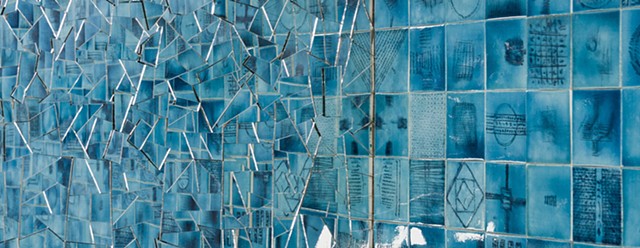Artist Statement
And strange to tell, among that earthen lot
Some could articulate, while others not;
And suddenly most impatient cried –
“Who is the potter, pray, and who the pot?”
Khayyam Neishabouri
The Iranian poet, Khayyam, who lived around 1048 A.D. deeply inspires me. He believes that the world is not stable, that people come from the clay (earth) and will become clay again. He says that no one ever comes back from the other world so you’d better “take the cash and waive the Rest, the brave music of a distant drum!” And a piece of ceramic is not stable, it can break very easily. It’s like this world, a beautiful and delicate place, but it can be gone in a second.
I was born in Iran and studied handicraft there. At the end of my BFA education, I began working with clay and realized that clay is one of the materials in the world deserving of most respect. Clay is earth. Clay is all of our histories. Clay is our fathers and mothers. I believe, as Khayyam, that we all come from the earth and that we go back to the earth. Because of this belief, I began to work with clay.
I also vigorously study Persian history, both the periods before and after the emergence of Islam. My artwork relates itself to ancient art and history and draws inspiration from all aspects of Persian architecture, painting, and ceramics. Infused in my work is their history and significant culture. You might not recognize it at once but as you look deeper you can see it.
I use a material that is paradoxically both most venerable and least valuable. Common clay I transmute into a beautiful piece of art, which I want to have the attraction and the power of culture, and art in it. Iranians believed that a potter does a very unique job because he can do this, change clay to valuable art.
I want to put thoughts in my art. I believe that my art should reveal. Art should make you think. I don’t want it to be nonsense or meaningless.
I have a deep interest in tiles. I work on tiles mostly. I’ve done sculpture but I'm most drawn to work with tiles. Working with two dimensional tiles for me came from the study of Persian painting. They believed that this world is an illusion of the other world or the better world. They didn’t try to make their painting like this world (3D). They didn’t use perspective in their painting; trying to fool the eye. All of their paintings are flat, two dimensional with no perspective. I am so inspired by the Persian paintings. I love the energetic and colorful space they created in their work. I always want to have that vividness, shininess and invented aperture. I make my own glazes and clay bodies so my work has that energy and soul. I want to deliver energy to the viewer.
Tiles are mostly used in a functional and/or industrial way these days. They rarely used as an art and I want to use this two dimensional material as an individual material. Since my undergrad days I have tried to bring the scent of a painting in my tiles with my own motives and patterns.
I still draw on my roots by using colors related to Iranian architecture. They used a lot of blue and turquoise in their tiles. Most parts of Iran are deserts and deserts represent a yellow – orange color. They used turquoise for the roof of the mosques and shrines to make a good combination between the yellow desert and the blue sky. The other reason for making the roof, blue, or turquoise was making that holy place closer to the sky which is considered a sacred place. Color plays a huge role in my work.
Calligraphy is another link to the traditions of Iran. I use lots of writing in my tiles. I write on my tiles to keep the mysterious beauty of them. I use calligraphy as an element of design for my work. It is one of the most important arts in Iran and it is connected to painting and poetry. Looking at Iranian paintings you can see the role calligraphy in the composition of the painting and it is always poetry which is related to the painting, paring the visual with the word.
“ Then said another – “Surely not in vain
My substance from the common Earth was ta’en,
That he who subtly wrought me into Shape
Should stamp me back to common Earth again. “
Khayyam Neishabouri
We are the history. Everyday people come and go. They are born and die. They are making the body of history. Artists create. I’ve always thought history should have a big role in artists’ works. It must have. We are the ones that make the history and at the same time we are using history in our life or works. Some day people are going to use our lives and work as a part of history.
